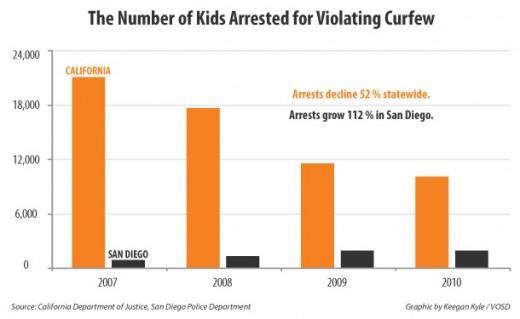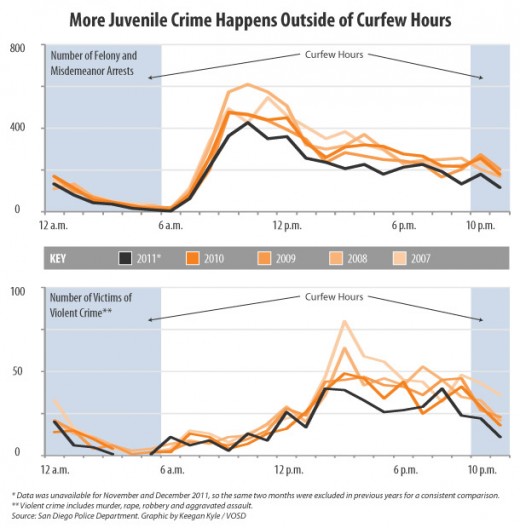No recent police initiative has received more praise from San Diego’s elected leaders than a program designed to swarm entire neighborhoods and arrest kids for breaking curfew.
Police conduct monthly curfew sweeps across the city’s urban core, including City Heights, southeastern neighborhoods and parts of downtown, and have arrested more than 2,500 kids in the past four years.
The program aims to cut crime by deterring kids from the city’s nighttime streets, where police say youth are more likely to become victims or perpetrators of violent crime.
But whether the program has actually achieved that goal is unclear. To date, police have never conducted a full analysis of the program’s impacts on crime. They’ve relied instead on anecdotes and isolated statistics to justify the effort. And some of proponents’ biggest claims are just not true.
We’ve been examining the sweeps in recent months to further understand the initiative and the debate surrounding it.
Here’s a simple six-step guide to what this major law enforcement push is all about and the weaknesses in the program’s justification that our reporting has revealed.
1. Watch the videos below.
Our friends at the Media Arts Center of San Diego produced a short video about a curfew sweep in City Heights in February. Dozens of volunteers, nonprofit groups and law enforcement officials participate alongside San Diego police each month.
Youth in the Media Arts Center’s Teen Producers Program also produced a video on curfew sweeps. They asked other teens and young adults what they think of the program.
KPBS reporter Amita Sharma and I discussed San Diego’s curfew sweeps, and my analysis of the program’s impact on crime.
2. Read this primer on San Diego’s curfew law and the police initiative.
San Diego prohibits minors from being out after 10 p.m.
The ban includes a few exceptions, such as attending church or a school-related activity, but if found breaking curfew, kids face up to a $250 fine.
The city’s actual curfew law isn’t anything new. It’s been in the books for more than a decade. What’s changed recently is how police have decided to enforce the law within certain neighborhoods.
In 2008, police began conducting monthly curfew sweeps in southeastern neighborhoods. They basically flooded the area with cops without warning and then arrested any kids found breaking curfew.
But unlike curfew sweeps elsewhere, San Diego police added an educational component to the initiative. They said kids can avoid paying a fine and erase the ticket from the record if they enroll in crime diversion classes.
Police and residents called the initiative a success and expanded it to City Heights in 2009 and downtown neighborhoods in 2010. Police say most kids arrested through the sweeps have completed diversion classes.
3. Check out the graphics below.
This graphic illustrates how San Diego’s push to increase curfew enforcement is unique across the state. While the number of curfew arrests declined statewide in the four-year period, arrests more than doubled in San Diego.
4. Read this overview of our biggest findings.
For years, police have claimed the sweeps have been responsible for a recent drop in juvenile crime. Without the program, police once warned the City Council, crime might go up.
However, our analysis of crime statistics from the last five years challenged that conclusion. Juvenile crime has fallen across the city and by even greater margins in places without the sweeps, as shown in the graphics below.
Police and other proponents have long said the sweeps are valuable because they increase enforcement during a particularly dangerous time period. They claimed most crime happens during curfew hours.
But the data, as illustrated in the graphic below, shows that description is not true. Most juvenile crime happens outside of curfew hours.
5. What you can watch for next.
Though police and elected leaders have faced fresh criticism of the sweeps, they’ve shown no sign of backing away from the initiative. The big question now is whether police will take new steps to evaluate the program in response to residents’ concerns.
It should also be interesting to see how police continue to justify the effort. Now that some of their long-held claims have been questioned or undermined, how will they argue to residents or council members why the initiative is valuable?
Before our coverage, police cited crime statistics to tout the program’s success. Now they argue its benefits cannot be statistically measured. Believing the sweeps might prevent one violent crime is enough for police to say the program is worthwhile.
6. Join the discussion.
Our findings spurred a fascinating discussion about the program’s value. Community advocates in City Heights have called for greater analysis of the sweeps and described them as divisive among residents. A City Heights community organizer called for less punitive measures on KPBS Midday Edition. Others have passionately defended the sweeps in story comments and emails.
For a sample of the conversation, I recommend checking out the comments section of our first story in the series and this roundup. You can also share your thoughts in the comments section below or by sending me an email.



